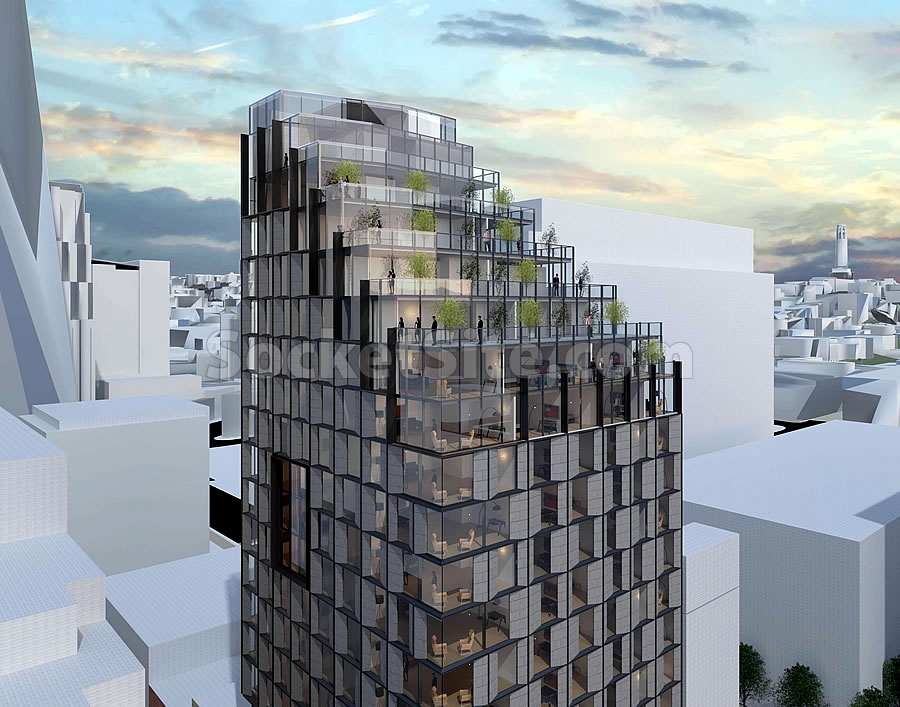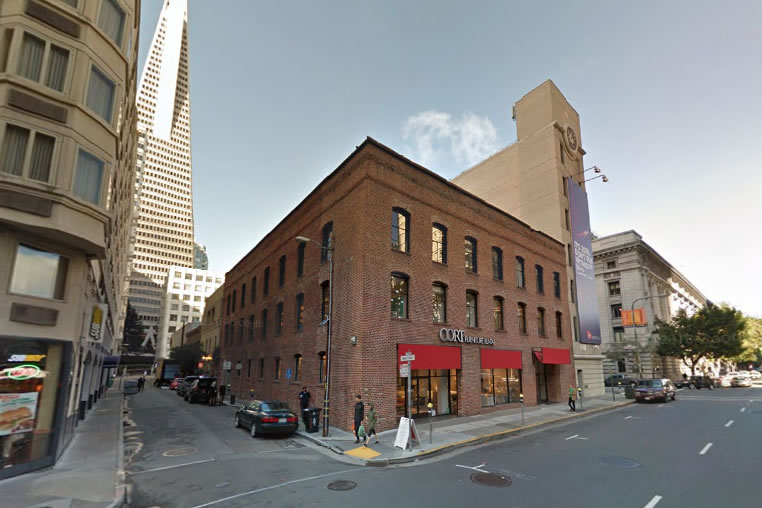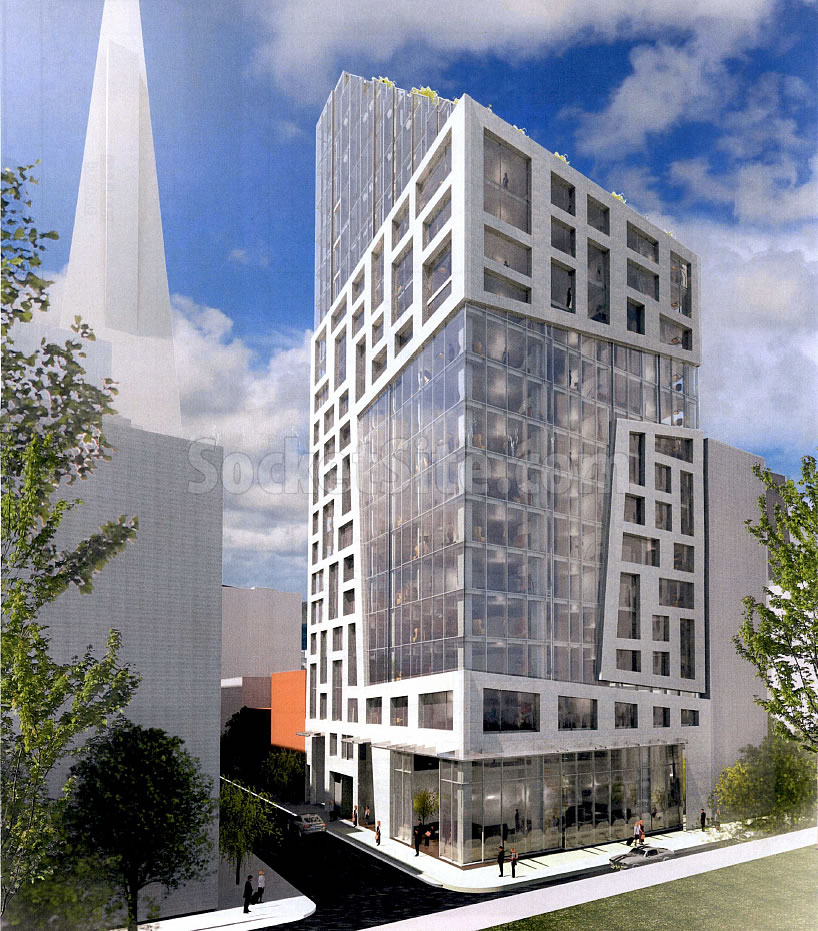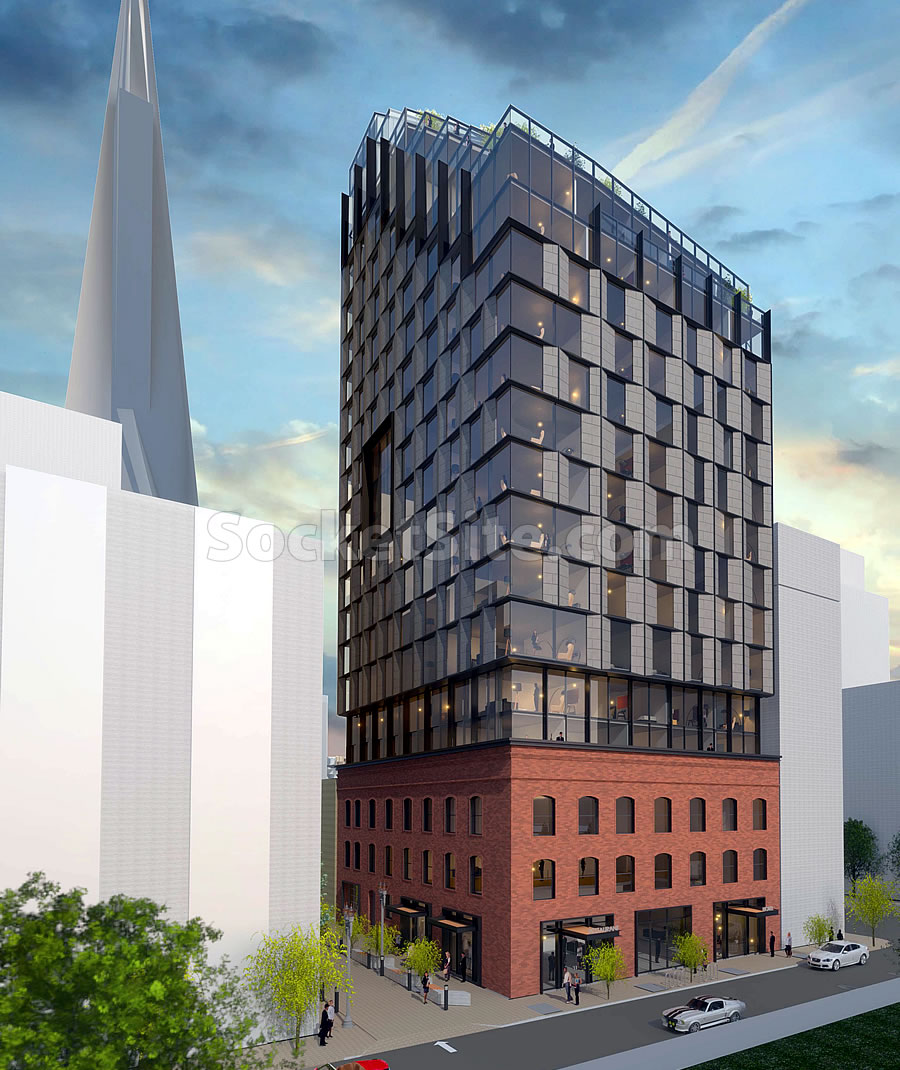As we first revealed back in early 2017:
The designs for a modern 200-foot-tall hotel and condo building to rise at 447 Battery Street, a site which is currently occupied by the three-story Cort Furniture Rental building at the corner of Battery and Merchant, have been drawn and formally submitted to San Francisco’s Planning Department for approval.
As designed by Heller Manus Architects for the Montgomery Realty Group, the proposed 19-story building includes a total of 182 hotel rooms over a 4,700 square foot restaurant and an underground garage for 24 cars.
And eight (8) condos would be spread across the top five floors of the tapered tower, with a single 4,300-square-foot penthouse and two private terraces across the top two.
But those plans have since been kicked to the curb.
Instead, the project team, which still includes Heller Manus, is now planning to save the façade of the existing building and construct a 15-story “addition,” an approach which would still yield a new 200-foot-tall tower on the site.
The condo component has been dropped from the proposed development as well. And as newly envisioned, the 18-story tower would now yield a total of 198 hotel rooms, ranging in size from 300 to 628 square feet, with a basement garage for 24 cars and two restaurants and bars, one fronting Merchant Street (which would be redeveloped as part of the project) and another across the tower’s top floor (with a private terrace).
And in terms of timing, assuming the project is approved, the project team is now expected to break ground at the end of next year (2020).




Another hotel project instead of condos – for the medium term future building new condos in SF is financially quite risky. Falling condo prices, stagnant or falling population and the highest construction costs in the world.
To be fair, I don’t think dropping what would have been 8 very expensive condos is going to make or break the housing market in San Francisco.
Where on earth do you see data that San Francisco’s population is stagnant or falling? The latest census numbers suggest otherwise and SF proper’s population is at an all time high…
It’s a falsehood he’s repeated many times. While the population growth of SF has slowed some, it hasn’t hit zero or gone negative.
[Editor’s Note: Population Growth of San Francisco Really Slows Its Roll]
Which is exactly what I said…
[Editor’s Note: And to which we added the actual, factual numbers and trend.]
It won’t be certain until the revised January 2019 population figure is released. The January 2018 population was revised down by 3873. That is less than the growth in 2018. If the January 2019 figure has the same downward revision the population on January 2019 will be less than it was on January 2018. Best case scenario is a stagnant population and that is a negative indicator.
Population in SF not falling despite your many refuted claims
The original design is so much better… Value engineering strikes again?
Not so much a case of VE as one of “facadism” I suspect.
The original design is awful. Why is it all wonky? Only for a visual effect, no real reason, just a gimmick. The new design is elegant and integrates the brick podium beyond mere ‘facadism.’
I would imagine Le Meridien and Pyramid Center will be putting up a pretty good fight against this.
Given the huge demand for hotel rooms in the city, a couple hundred extra rooms added to the inventory amounts to a drop in the pocket, and would have little to zero impact on hotel room rates. I very much doubt Le Meridien or Pyramid Center would waste their time trying to battle this project, and even if they did, there is very little they could do about it
People often have to stay near airport for SF conferences due to hotel shortage, which leads to some conferences not choosing SF( in addition to the rampant crime, open drug use and street zombies). More hotels might actually help all
I like it, and the pedestrianizing of the Merchant Street would be a great improvement as well. Let’s go!
Not every facade is worth saving. The original looks way better.
Agree entirely.
At least the Shelby GT made it into both renderings.
And isn’t getting swallowed by pavement(?) this time around.
I’m going with curtain #2: no, not every facade – or two – is worth saving, but with some it makes sense: it’s simple and durable, the brick makes a nice contrast to the glass and anodized/blackened metal of the tower, and it’s one of a very limited number of buildings remaining from the era when this was the produce market.
And five stars for the rendering: the background buildings have been treated for what they are – background – rather than poorly drawn attempts at realism, and the detailed look into the corner rooms is kewl! (sadly there’re no ideas offered for TV placement, but one can’t have everything).
Both of these are interesting. I wish we were building homes for people that live here instead of hotels
I’m glad they saved the brick facade. It has character. The building on top of it makes it looks like the the brick building is wearing a beehive hairdo.
This is such a bad idea. Can’t we keep just a teeny weeny, itsy bitsy little bit of Old San Francisco? Or do we have be be Dallas now?
Do you mean like the majority of the city that is original Victorian or Edwardian style architecture?
Hilariously out of touch. The city has an extremely diverse mixture of architectural styles from different eras. That isn’t new.
I’m not mad at this design. I’d rather support the blatant old-with-new-on-top approach than some sort of drunken post-modernist design—esp when the architects are not trying to play matchy-matchy with the existing structure/facade.
Do developers of new hotels have to provide BMR units or pay in-lieu fees? (If not, that may explain choice of hotels over condos/apartments.)
No, hotels and office buildings do not have to provide BMRs…the entire burden falls on the new residents who will buy the condos/rent the apartments. And thanks to Mr Peskin, the BMR percentage doesn’t pencil, not that he cares or did a financial feasibility study. Another case of the Progressives stopping provision of housing, not helping it.
Developers actually shoulder the full burden of BMR fees in the form of lower profit margins/returns and will continue to charge as much as the market will bear for every unit built, regardless of their cost bases; units aren’t priced/sold on a cost-plus basis.
That being said, affordable housing fees can certainly impact the market in the form of less supply/choice if said fees result in fewer units being built due to the aforementioned (lack of) penciling and economic realities.
But again, the direct burden remains on developers and the owners of developable property.
Weebly’s first real office was in that building.
The new clashes with the old. Just continue the old brick style to the top and earn a LEED level given that its more feasible without so much glass.
UPDATE: Proposed Terraced Tower and Expectations Take Three